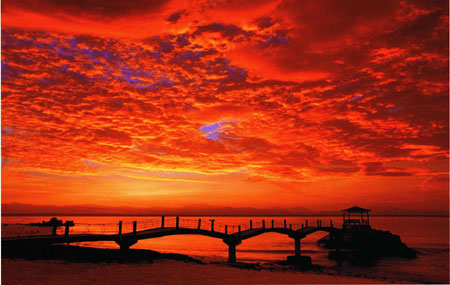Green China
Island getaway may be a costly dream
Updated: 2011-04-27 14:25
By Shi Ying Ying (China Daily)
 |
|
Wuzhizhou Island Resort Center is one of the successful island developments in Sanya, Hainan province. It took more than 15 years and 200 million yuan for the developer to make it into a tourist attraction. [Photo / China Daily] |
It is not easy
Ding Feng has a few things to say to potential investors. He is vice-general manager of the Sanya Wuzhizhou Island Resort Center, which is on a 1.48 million-square-meter island off Sanya in South China's Hainan province. He has spent more than 15 years and more than 200 million yuan on Wuzhizhou Island, so he is qualified.
Today, he said, "You see visitors diving, sailing, riding water motorcycles and playing beach volleyball on an island lined with coconut palms along sandy beaches. But when we first came here in 1995, there was nothing - no people, fresh water, electricity, dock, road, nothing but more than 2,000 kinds of plants."
|
||||
It took Ding several years to realize the amount needed to be doubled.
"Everything was tougher than we-expected, and the worst thing is we had no one to learn from. At the very beginning, it cost more to transport a bag of sand to the island than buy one. Practical problems were everywhere.
"For example, we thought one dock would be enough - until we figured the island had southwester storms for half a year and northeasters for the other half. Ships heaving in one dock wouldn't be safe for the whole year, so the budget for dock-building had to be doubled. Now we've got two docks on opposite directions of the island."
Things like this aren't in a textbook or anyone's experience, at least in China, Ding said. His company went through a few general managers before the company started to make money. Ding said the island finally broke even three years ago.
The company even thought about giving up in 1999 because of Hainan's poor economy then. "Nobody was willing to take the island when we put it in the market and, to be honest, that's the only reason we still have it now," Ding said.
"Island tourism has become popular only in recent years, especially after the local government became interested in developing Haitang Bay, where our island is." He said construction is about to begin on a five-star hotel costing 6.8 billion yuan. "Now many investors want to take the island, but now we wouldn't sell it."
Despite the resort Ding's company developed and the luxury hotel that's on tap, Wuzhizhou Island is on the list of 176 available islands, along with four others that Sanya wants to develop further. The island has received 3.2 million visitors since it opened to the public in 1998.
Why resources matter
"Developing an unoccupied island is like building a small society," Ding said. "It's not at all about you, the investor, taking an empty island with no residents, but about taking everything into consideration." Environmental protection is a big part of that.
Ding said his company put its waste into a landfill the first year, then switched to incineration, bringing oil engines and other equipment onto the island. "Incineration, however, still has the risk of causing a forest fire, so we stopped using it and now carry whatever has been brought to the island off the island.
"Restrictions on how many tourists can land on the island have been made as well," he said, "and our current limit is 3,000 per day." Those kinds of practices recognize that the island's natural resources are key draws to tourists, Ding said.
Island development is more attractive now than it was 15 years ago, Ding said, but the barriers to doing it are higher. It is certainly more complicated and more expensive.
"You have to be patient enough and have a fat wallet. Plans for both the island's short-term infrastructure and a long-term blueprint need to be prepared. And most important," he said, "pick the right island."
'Gone in seconds'
Not everyone is confident the offer of 176 islands will attract hordes of investors. Tang Hongsen, a professor at Zhejiang Ocean University, hears an echo of 2003, when the State Oceanic Administration for the first time allowed individuals and organizations to exploit such opportunities.
"But the moves did not gather momentum, as developers realized the enormous transportation costs for the construction material needed to develop the island," Tang said. "It's also costly to equip the islands with electricity and clean water."
Chen Xiaoxian, 35, could not agree more. A native of Wenzhou, she was the first in the area to rent the 80,000 square meters of nearby Zhuyu Island seven years ago.
"It was definitely much more difficult than I expected. My investment of over 1 million yuan was like water absorbed by the sands in the desert, gone in seconds."
She said she spent "more than 100 yuan to transport one cubic meter of sand to the island. Most of the money went for developing wharf facilities, electricity and clean water supplies, roads and environmental protection."
There was no Island Protection Law in China when Chen signed the five-year rental contract with the local government in 2004. "I only needed to pay a small amount of rent each year - something like 30,000 to 40,000 yuan - when both the local government and I reached an agreement that our bottom line was to take extra care of the environment."
Chen said it cost more than 200,000 yuan in 2007 alone to bring in seashells. "The idea was to build a sustainable resort and attract high-end tourists, but it turned out we didn't earn a penny at all."
The contract expired in 2009 and the island has been returned to the government. When asked whether she would invest in the island again after the release of the new list, Chen hesitated.
"It all depends on the details of the policy. You know you still have opportunities there. I know there's a luxury yacht club nearby and I've got all these years of experience of running an island."
E-paper

The perfect cut
Companies need to revamp, standardize to stave off quality challenges
Going the distance
The great lake
Mixed Results
Specials

My China story
Foreign readers are invited to share your China stories.

90th anniversary of the CPC
The Party has been leading the country and people to prosperity.

Setting the pace in Turkey
China is building a 158-km high-speed railway in Turkey.




